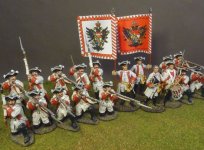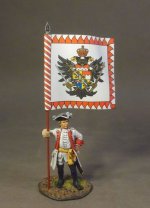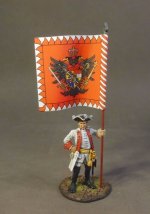THE BATTLE OF BUSHY RUN 1763
The Battle of Bushy Run was fought on August 5-6, 1763, in western Pennsylvania, between a British column under the command of Colonel Henry Bouquet and a combined force of Delaware, Shawnee, Mingo, and Huron warriors. This action occurred during Pontiac's Rebellion. Though the British suffered serious losses, they routed the Native American Tribesmen and successfully relieved the garrison of Fort Pitt.
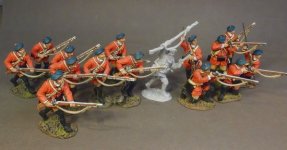
The mighty forks of the Ohio River, so critical to control of the western Pennsylvania frontier, were in the hands of the French & their Native allies no more. Fort Duquesne had fallen ... Fort Pitt stood in its stead.
Still, it was a hotbed of contention. For the British garrison, under siege by an Indian alliance, it could soon be a tomb. Canada may have surrendered in 1760, but that succeeded only in cooling the conflict between two great European powers, England & France. Within the wilderness, the war was far from over. It merely changed names. It now was Pontiac's Rebellion, named after the Ottawa chief who forged an alliance in the Old Northwest. With France waiting for an opportunity to present itself, the war in the wilderness waged on.
Earlier, in 1755, it had been General Braddock plodding along in the forest, expecting ambush. It came, all too soon, and resulted in the Battle On The Monongahela, and the Braddock's Defeat debacle. Now, it seemed it was Bouquet's turn. Though his force was comprised of grizzled veterans, many were wounded or sick. He traded in the invalids for the gruff frontiersmen. The ambush could come at any turn. The addition of the frontiersmen was the only insurance against the inevitable.
It was to become a situation that closely resembled the predicament of Braddock years earlier ... an advance guard ran into hostiles, support was sent forward, and after some stiff firing, a bayonet charge sent the Indians from whence they had come. The apparent successful repulse was a ruse, for almost immediately renewed fire broke out, from the woods on both flanks and the rear of the main British force. It was Braddock's Defeat all over again ... or was it? It certainly could have been, but the difference here was the maintenance of order. And that occurrence rests squarely on the shoulders of the troops' confidence in their commander. Bouquet formed up in a near-hollow square on a hillside. Indians dashed forward. Fire was exchanged. Often a bayonet charge put an end to things for a time. The scenario repeated ... all day.
It was an almost even match, as it was a force of some 400 Indians opposing an equal number of His Majesty's troops. Bouquet decided upon trickery for day two. He feigned a retreat, lured the Indians in, then hit them on the flanks with his light infantry companies. The maneuver carried the day. Though Indian casualties were lighter than that of the British, the Battle of Bushy Run, August 5 & 6, 1763, was over, and broke the back of Indian resistance in these parts. Fort Pitt was relieved. The settlements came. A great city would one day stand at this fork in a wilderness river.
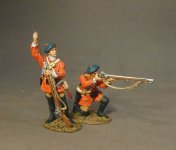
BRLX-04
THE BATTLE OF BUSHY RUN 1763,
LIGHT INFANTRY COMPANY,
2 FIGURES SKIRMISHING,
(2pcs)
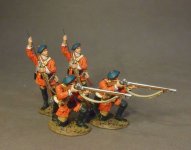
BRLX-04N
THE BATTLE OF BUSHY RUN 1763,
LIGHT INFANTRY COMPANY,
4 FIGURES SKIRMISHING,
(4pcs)
THE RAID ON ST. FRANCIS 1959
Lacrosse has its origins in a tribal game played by eastern Woodlands Native Americans and by some Plains Indians tribes in what is now Canada.
The game began with the ball being tossed into the air and the two sides rushing to catch it. Because of the large number of players involved, these games generally tended to involve a huge mob of players swarming the ball and slowly moving across the field. Passing the ball was thought of as a trick, and it was seen as cowardly to dodge an opponent.
Lacrosse is one of the oldest team sports in North America. There is evidence that a version of lacrosse originated in what is now Canada as early as the 17th century
Traditional lacrosse games were sometimes major events that could last several days. As many as 100 to 1,000 men from opposing villages or tribes would participate. The games were played in open plains located between the two villages, and the goals could range from 500 yards ,to 6 miles apart!
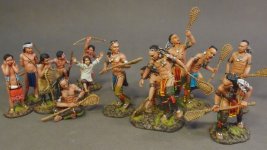
There are traditionally three areas of scoring on the stickball pole. There is a mark, about chest high on the pole, and when scored above, awards one point. Contact below that point is not scored. The top half of the pole, well above arms reach, is worth two points when hit. The very top of the pole, usually embellished with a large figure of a fish, is worth three points. In recreational games, scoring is loosely kept, most times by the audience or a few players. Games typically reach around twenty points before concluding
Lacrosse traditionally had many different purposes. Some games were played to settle inter-tribal disputes. This function was essential to keeping the Six Nations of the Iroquois together. Lacrosse was also played to toughen young warriors for combat, for recreation, as part of festivals, and for the bets involved.
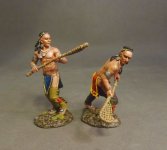
WIM-15
THE RAID ON ST. FRANCIS 1759,
Woodland Indians,
Lacrosse Players,
(2 pcs)
More to follow......................................
The Battle of Bushy Run was fought on August 5-6, 1763, in western Pennsylvania, between a British column under the command of Colonel Henry Bouquet and a combined force of Delaware, Shawnee, Mingo, and Huron warriors. This action occurred during Pontiac's Rebellion. Though the British suffered serious losses, they routed the Native American Tribesmen and successfully relieved the garrison of Fort Pitt.

The mighty forks of the Ohio River, so critical to control of the western Pennsylvania frontier, were in the hands of the French & their Native allies no more. Fort Duquesne had fallen ... Fort Pitt stood in its stead.
Still, it was a hotbed of contention. For the British garrison, under siege by an Indian alliance, it could soon be a tomb. Canada may have surrendered in 1760, but that succeeded only in cooling the conflict between two great European powers, England & France. Within the wilderness, the war was far from over. It merely changed names. It now was Pontiac's Rebellion, named after the Ottawa chief who forged an alliance in the Old Northwest. With France waiting for an opportunity to present itself, the war in the wilderness waged on.
Earlier, in 1755, it had been General Braddock plodding along in the forest, expecting ambush. It came, all too soon, and resulted in the Battle On The Monongahela, and the Braddock's Defeat debacle. Now, it seemed it was Bouquet's turn. Though his force was comprised of grizzled veterans, many were wounded or sick. He traded in the invalids for the gruff frontiersmen. The ambush could come at any turn. The addition of the frontiersmen was the only insurance against the inevitable.
It was to become a situation that closely resembled the predicament of Braddock years earlier ... an advance guard ran into hostiles, support was sent forward, and after some stiff firing, a bayonet charge sent the Indians from whence they had come. The apparent successful repulse was a ruse, for almost immediately renewed fire broke out, from the woods on both flanks and the rear of the main British force. It was Braddock's Defeat all over again ... or was it? It certainly could have been, but the difference here was the maintenance of order. And that occurrence rests squarely on the shoulders of the troops' confidence in their commander. Bouquet formed up in a near-hollow square on a hillside. Indians dashed forward. Fire was exchanged. Often a bayonet charge put an end to things for a time. The scenario repeated ... all day.
It was an almost even match, as it was a force of some 400 Indians opposing an equal number of His Majesty's troops. Bouquet decided upon trickery for day two. He feigned a retreat, lured the Indians in, then hit them on the flanks with his light infantry companies. The maneuver carried the day. Though Indian casualties were lighter than that of the British, the Battle of Bushy Run, August 5 & 6, 1763, was over, and broke the back of Indian resistance in these parts. Fort Pitt was relieved. The settlements came. A great city would one day stand at this fork in a wilderness river.

BRLX-04
THE BATTLE OF BUSHY RUN 1763,
LIGHT INFANTRY COMPANY,
2 FIGURES SKIRMISHING,
(2pcs)

BRLX-04N
THE BATTLE OF BUSHY RUN 1763,
LIGHT INFANTRY COMPANY,
4 FIGURES SKIRMISHING,
(4pcs)
THE RAID ON ST. FRANCIS 1959
Lacrosse has its origins in a tribal game played by eastern Woodlands Native Americans and by some Plains Indians tribes in what is now Canada.
The game began with the ball being tossed into the air and the two sides rushing to catch it. Because of the large number of players involved, these games generally tended to involve a huge mob of players swarming the ball and slowly moving across the field. Passing the ball was thought of as a trick, and it was seen as cowardly to dodge an opponent.
Lacrosse is one of the oldest team sports in North America. There is evidence that a version of lacrosse originated in what is now Canada as early as the 17th century
Traditional lacrosse games were sometimes major events that could last several days. As many as 100 to 1,000 men from opposing villages or tribes would participate. The games were played in open plains located between the two villages, and the goals could range from 500 yards ,to 6 miles apart!

There are traditionally three areas of scoring on the stickball pole. There is a mark, about chest high on the pole, and when scored above, awards one point. Contact below that point is not scored. The top half of the pole, well above arms reach, is worth two points when hit. The very top of the pole, usually embellished with a large figure of a fish, is worth three points. In recreational games, scoring is loosely kept, most times by the audience or a few players. Games typically reach around twenty points before concluding
Lacrosse traditionally had many different purposes. Some games were played to settle inter-tribal disputes. This function was essential to keeping the Six Nations of the Iroquois together. Lacrosse was also played to toughen young warriors for combat, for recreation, as part of festivals, and for the bets involved.

WIM-15
THE RAID ON ST. FRANCIS 1759,
Woodland Indians,
Lacrosse Players,
(2 pcs)
More to follow......................................


